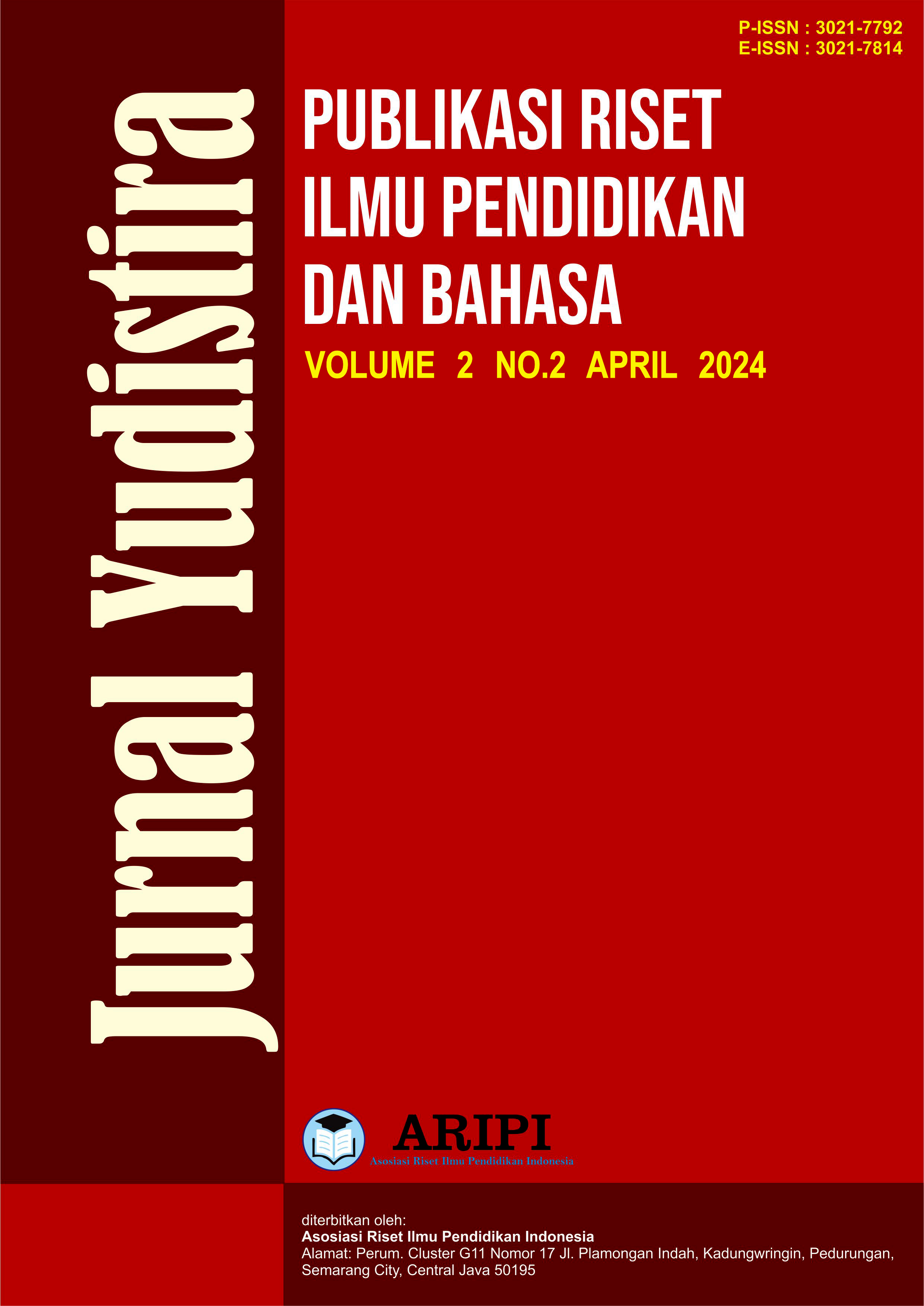Pentingnya Penyesuaian Kurikulum Untuk Anak Berkebutuhan Khusus Disekolah Dasar
DOI:
https://doi.org/10.61132/yudistira.v2i2.560Keywords:
Adjustment, Curriculum in Education, InclusiveAbstract
The research approach uses descriptive qualitative using the case study method. Data collection is done through observation, interviews and document analysis. The results of the study are based on data analysis and observations in the field, namely: The First, Curriculum planning and learning of inclusive education begins with making syllabus, lesson plans, and PPI.. Second, Organizing the curriculum and learning of inclusive education starts with grouping and dividing the tasks for the implementers of curriculum and learning plans, Third, the implementation of the curriculum and learning of inclusive education in children with special needs has a special service program for each student's suitability according to the RPP and PPI that has been prepared. Fourth, Curriculum evaluation and learning of inclusive education is carried out by providing a review of the ongoing implementation process and the results of assessments of the curriculum and student learning.
Downloads
References
Armand, F. (2003). Social Marketing Models for Product-Based Reproductive Health Programs: A Comparative Analysis. Occasional Paper Series. Washington, DC. Retrieved from www.cmsproject.com.
Bator, R. J., Bryan, A. D., & Schultz, P. W. (2011). Who Gives a Hoot?: Intercept Surveys of Litterers and Disposers. Environment and Behavior, 43(3), 295–315. https://doi.org/10.1177/0013916509356884.
Belair, A. R. (2003). Shopping for Your Self: When Marketing becomes a Social Problem. Dissertation. Concordia University, Montreal, Quebec, Canada.
Cavallaro, C.C. & Haney, M., Preschool Inclusion. Paul H. Brookes Publishing Co. Baltimore: Maryland, 1999.
Chain, P. (1997). Same or Different?: A Comparison of the Beliefs Australian and Chinese University Students Hold about Learning’s Proceedings of AARE Conference. Swinburne University. Available at: http://www. swin.edu.au/aare/ 97pap/CHAN97058.html, diakses tanggal 27 Mei 2000.
Delphie, Bandi, Learning of Children with Special Needs (in the Setting of Inclusive Education). Bandung: PT Refika Aditama, 2006
Delphie, Bandi, Learning of Children with Special Needs (in the Setting of Inclusive Education). Bandung: PT Refika Aditama, 2006
Hidayati, S.N. (2016). Pengaruh Pendekatan Keras dan Lunak Pemimpin Organisasi terhadap Kepuasan Kerja dan Potensi Mogok Kerja Karyawan. Jurnal Maksipreneur: Manajemen, Koperasi, dan Entrepreneurship, 5(2), 57-66. http://dx.doi.org/10.30588/SOSHUMDIK.v5i2.164.
Jackman, Hilda l., Early Education curriculum: A Child’s Connection to the world, fifth edition. United States of America: www.cengagebrain.com. 2012 Vakil, S., Welton, E., O'Connor, B., & Kline, L. S., Inclusion Means Everyone! The Role of the Early Childhood Educator when Including Young Children with Autism in the Classroom. Early Childhood Education Journal, 36(4), 321326. Retrieved from https://link.springer.com/article/10.1007%2Fs10643-008-0289-5
Kotler, P., & Lee, N. R. (2009). Up and Out of Poverty: The Social Marketing Solution. New Jersey: Pearson Education, Inc.
Latief, Pendidikan Inklusi Masih Banyak Kendala. Kompas.com, p. 1. November 04, 2009.
Lindawati (2015). Analisis Faktor yang Mempengaruhi Perilaku Ekonomi dan Kesejahteraan Rumah Tangga Petani Usahatani Terpadu Padi-Sapi di Provinsi Jawa Barat. Institut Pertanian Bogor. Retrieved from http://repository.ipb.ac.id/ handle/123456789/85350.
LPPSP. (2016). Statistik Indonesia 2016. Badan Pusat Statistik, 676. Jakarta. Diakses dari https://www.LPPSP.go.id/index.php/publikasi/326.
Moleong, Lesey J., Metodologi Penelitian Kualitatif. Bandung: Remaja Rosdakarya Offset, 2001.
Norsyaheera, A.W., Lailatul, F.A.H., Shahid, S.A.M., & Maon, S.N. (2016). The Relationship Between Marketing Mix and Customer Loyalty in Hijab Industry: The Mediating Effect of Customer Satisfaction. In Procedia Economics and Finance (Vol. 37, pp. 366–371). Elsevier B.V. https://doi.org/10.1016/S2212-5671(16)30138-1.
Porter, Gordon, Disability and Inclusive Education, A Paper prepared for the InterAmerican Development Bank Seminar on Inclusion and Disability Santiago, Chile, March 16, 2001.
Rianto,Yatim. Metodologi Penelitian Pendidikan, Suatu Tinjauan Dasar. Surabaya: SIC Surabaya, 2016.
Risdwiyanto, A. & Kurniyati, Y. (2015). Strategi Pemasaran Perguruan Tinggi Swasta di Kabupaten Sleman Yogyakarta Berbasis Rangsangan Pemasaran. Jurnal Maksipreneur: Manajemen, Koperasi, dan Entrepreneurship, 5(1), 1-23. http://dx.doi.org/10.30588/SOSHUMDIK.v5i1.142.
Risdwiyanto, A. (2016). Tas Kresek Berbayar, Ubah Perilaku Belanja? Kedaulatan Rakyat, 22 Februari, 12.
Robbins, Stephen P. and Mary Coulter, Management of the tenth edition. Jakarta: Erlangga, 2010
Saravanakumar & Jazeel.A.M (2017), ”Challenges for Improving Quality in Education at Primary and Secondary Schools in India and Sri Lanka”, International Journal of Social Welfare and Management, Vol:9. No:2 ISSN:0975-0231.ICV 2015:76.43, May-August, 2017.
Shakespeare, T. & Watson, N, The Social Model of Disability: An Outdated Ideology? Research in Social Science and Disability, Exploring Theories and Expanding Methodologies, 3, 9-28. 2001.
Sutopo, H.B., Seminar dan Lokakarya Penelitian Kualitatif. Surabaya: Unipres IKIP Surabaya. 1997.
Sugiyono, Metode Penelitian Kuantitatif, Kualitatif, dan R&D. Bandung: Alfabeta, 2016.
StatSoft, Inc. (1997). Electronic Statistic Textbook. Tulsa OK., StatSoft Online. Available at: http://www.statsoft.com/textbook/stathome.html, diakses tanggal 27 Mei 2000.
Tirana, Inclusive Education for Children with Special Educational Needs in Albania, Italian agency: Best Practices, 2017
Winter, Suzanne, Inclusive early Childhood Education A Collaborative Approach, New Jersey: Library of Congres in Publication Data by Pearson Education, 2007.
Downloads
Published
How to Cite
Issue
Section
License
Copyright (c) 2024 Jurnal Yudistira : Publikasi Riset Ilmu Pendidikan dan Bahasa

This work is licensed under a Creative Commons Attribution-ShareAlike 4.0 International License.






